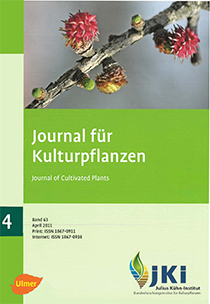Glucosinolate profiles of disomic rapeseed-radish chromosome addition lines
DOI:
https://doi.org/10.5073/JfK.2011.04.02Keywords:
Chromosome addition, rapeseed, oil radish, glucosinolate profile, Heterodera schachtii, resistanceAbstract
The glucosinolate (GSL) content and -profile of a complete series of nine disomic rapeseed-radish chromosome addition lines (2n = 38 + 2, a to i) was estimated and compared to that of radish as donor and rapeseed as recipient of the alien chromosomes. Modification of identical genetic rapeseed background by single radish chromosomes allows the assignment of GSL biosynthesis steps to individual radish chromosomes. Addition line a was found to have a five times higher aliphatic GSL content than the rapeseed parent. Radish-specific GSLs, glucoraphenin and glucoerysolin, were synthesized exclusively in addition line g. Addition line i produced sinigrin, not detectable in both parents. The variations in GSL content are not correlated with resistance against beet cyst nematode (Heterodera schachtii Schmidt).
Published
Issue
Section
License
The content of the journal is licensed under the Creative Commons Attribution 4.0 License. Any user is free to share and adapt (remix, transform, build upon) the content as long as the original publication is attributed (authors, title, year, journal, issue, pages).
The copyright of the published work remains with the authors. The authors grant the Journal of Cultivated Plants, the Julius Kühn-Institut and the OpenAgrar repository the non-exclusive right to distribute and exploit the work.







